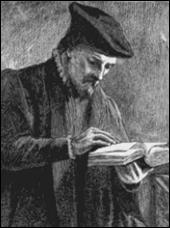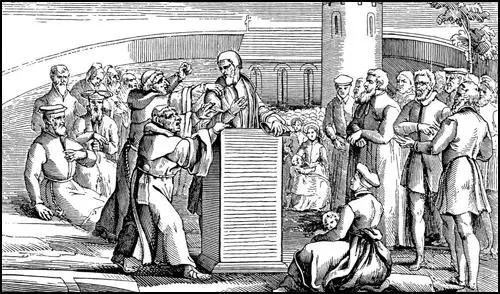Thomas Bilney

Thomas Bilney was born in Norfolk in about 1495. He went to Cambridge University at an early age.
Bilney read law at Trinity Hall and became a regular visitor to the White Horse tavern that had been nicknamed "Little Germany" as the Lutheran creed was discussed within its walls, and the participants were known as "Germans". Those involved in the debates about religious reform included Thomas Cranmer, Hugh Latimer, William Tyndale, Nicholas Ridley, Miles Coverdale and Matthew Parker. (1)
In September 1519 Bilney was ordained a priest at Ely. He also served as a proctor of the university. P. R. Carter claims that "Bilney might have settled quietly into life as a Cambridge don, had he not undergone a personal religious conversion". In 1516 Bilney purchased a copy of Erasmus's recent Latin translation of the New Testament. He claims that the following passage had dramatic spiritual consequences: "It is a true saying, and worthy of all men to be embraced, that Christ Jesus came into the world to save sinners, of whom I am the chief and principal". Bilney later recalled: "This one sentence, through God's instruction and inward working, which I did not then perceive, did so exhilarate my heart, being before wounded with the guilt of my sins, and being almost in despair, that immediately I felt a marvelous comfort and quietness." (2)
Thomas Bilney: Radical Preacher
Thomas Bilney became a well-known preacher against idolatry. Twice he was pulled from his pulpit by some members of his congregation. (3) At Ipswich, Bilney denounced pilgrimages to popular shrines like Our Lady of Walsingham and warned of the worthlessness of prayers to the saints, while at Willesden he attacked the custom of leaving offerings before images. Bilney called on Henry VIII to destroy these images. (4)
In 1527 Bilney's attacks "on the insolence, pomp, and pride of the clergy" drew the attention of Cardinal Thomas Wolsey. On 29th November, Bilney was brought before Wolsey and a group of bishops, priests, and lawyers at Westminster. Also in attendance was Sir Thomas More. It has been argued by Jasper Ridley: "This was unprecedented, for a common lawyer and layman would not ordinarily have joined the bishops and canon lawyers in the examination of a heretic." (5)
| Spartacus E-Books (Price £0.99 / $1.50) | ||||||
|---|---|---|---|---|---|---|
Thomas Bilney declared that he had not "taught the opinions" of Martin Luther. Bilney was now handed over to Bishop Cuthbert Tunstall who declared he "was a wicked and detestable heretic". Bilney was held in custody and on 7th December he agreed to recant his beliefs. According to John Foxe: "He was sentenced to prison for some time and forced to do penance by going before the procession at St. Paul's bareheaded and carrying a fagot on his shoulder, then standing before the preacher during the sermon." (6)
Execution in Norwich
Bilney remained in prison until his release early in January 1529. On his return to Cambridge he went to see Hugh Latimer and asked him to hear his confession. (7) According to John Foxe: "Latimer was so moved by what he heard that he left his study of the Catholic doctors to learn true divinity. Where before he was an enemy of Christ, he now became a zealous seeker of Him... Latimer and Bilney stayed at Cambridge for some time, having many conversations together; the place they walked soon became known as Heretics' Hill. Both of them set a good Christian example by visiting prisoners, helping the needy, and feeding the hungry." (8)

Thomas Bilney experienced great guilt for recanting. In early 1531 Bilney announced to his friends that he was "going up to Jerusalem" and set off for Norwich to court martyrdom. He began to preach in the open air, renounced his earlier recantation, and distributed copies of the English Bible that had been translated by William Tyndale. He was arrested in March and as a relapsed heretic he knew he would be burnt at the stake. (9)
John Foxe later described his execution at Norwich in August 1531: "Bilney approached the stake in a layman's gown, his arms hanging out, his hair mangled by the church's ritual divestiture of office. He was given permission to speak to the crowd and told them not to blame the friars present for his death and then said his private prayers. The officers put reeds and wood around him and lit the fire, which flared up rapidly, deforming Bilney's face as he held up his hands." Foxe claimed he called out "Jesus" and "I believe". (10)
Jasper Ridley, the author of The Statesman and the Fanatic (1982) points out that no heretics were burned between 1521 and 1529 when Cardinal Thomas Wolsey was Lord Chancellor. However, things changed when Sir Thomas More replaced Wolsey: "Apart from other factors, these heretics were burned when More was Chancellor because they refused to recant, or, having recanted, relapsed into heresy, whereas in Wolsey's time all the heretics whom he examined recanted at their trial. But there is no doubt that at least part of the reason is that More was a far more zealous persecutor than Wolsey." (11)
Primary Sources
(1) John Foxe, Book of Martyrs (1563)
Thomas Bilney was brought up in the University of Cambridge, even as a child studying the liberal sciences and laws. But at last, having found a better teacher in the Holy Spirit, he gave up his study of man's laws to learn the Word of God.
Excited by his love of true religion and godliness, Bilney felt a need, to spread the gospel to others. He was quite successful in this, converting, among others, Thomas Arthur and Hugh Latimer. Soon Bilney left the university to travel widely, teach, and preach, accompanied by Thomas Arthur.
Bilney's attacks on the insolence, pomp, and pride of the clergy soon drew the attention of Thomas Wolsey, the cardinal of York, who ordered both Bilney and Arthur imprisoned. On November 29, 1527, Bilney and Arthur were brought before Wolsey and a group of bishops, priests, and lawyers at Westminster.
Asked if he had privately or publicly taught the opinions of Martin Luther or anyone else against the church, Bilney said that he hadn't. He was then asked if he hadn't previously sworn to actively oppose this type of teaching wherever it was found. Bilney admitted he had sworn to do that but only under pressure, not legally. Told to recant his errors, Bilney refused, saying he would stand on his conscience; he was declared a heretic.
From December 5-7, Bilney continued to take the position that he had done nothing against the church doctrine and asked permission to call witnesses to that effect. No witnesses were allowed, since he had already been declared a heretic, and on December 7 he was given his last chance to recant before being sentenced. On the advice of his friends, Bilney gave in and was absolved by the bishop. He was sentenced to prison for some time and forced to do penance by going before the procession at St. Paul's bareheaded and carrying a fagot on his shoulder, then standing before the preacher during the sermon.
Returning to Cambridge in 1528, Bilney fell into a deep depression that nothing could lift. His friends stayed with him day and night, afraid that he might kill himself if left alone. This depression stayed with him until 1531; at which time Bilney decided he could no longer deny God's truth, said good-bye to his friends, and left to resume preaching in Norfolk. He urged everyone there to learn from his example and never trust their friends' advice when it came to matters of religion and conscience. He had denied God's truth once to save his life but never would again.
Bilney was soon arrested and given to the city's sheriffs for execution, one of whom, Thomas Necton, was a close friend. Although Necton was powerless to stop Bilney's execution, he was able to make his waiting more comfortable than normal, even allowing friends to visit him the night before he died.
Bilney approached the stake in a layman's gown, his arms hanging out, his hair mangled by the church's ritual divestiture of office. He was given permission to speak to the crowd and told them not to blame the friars present for his death and then said his private prayers.
The officers put reeds and wood around him and lit the fire, which flared up rapidly, deforming Bilney's face as he held up his hands and called out "Jesus" and "I believe."
Bilney's travel, teaching, and example were very influential at Cambridge, drawing many there to Christ. Among those affected were Hugh Latimer, Dr. Barnes, Dr. Thistel, Master Fooke, Dr. Warner, and Master Soude.
(2) Jasper Ridley, The Statesman and the Fanatic (1982)
Bilney was burned as a relapsed heretic in Norwich; in December, Bayfield the monk and Tewkesbury the leather-vendor were burned at Smithfield in London; and in April 1532 James Bainham, a barrister of the Middle Temple, who was the son of a knight of' Gloucestershire, and had married Simon Fish's widow, was burned at Smithfield. It would be an over-simplification to claim that these heretics were burned between October 1529 and May 1532, whereas none was burned between 1521 and 1529, because More had succeeded Wolsey as Lord Chancellor. Apart from other factors, these heretics were burned when More was Chancellor because they refused to recant, or, having recanted, relapsed into heresy, whereas in Wolsey's time all the heretics whom he examined recanted at their trial. But there is no doubt that at least part of the reason is that More was a far more zealous persecutor than Wolsey.
Student Activities
Henry VIII (Answer Commentary)
Henry VII: A Wise or Wicked Ruler? (Answer Commentary)
Henry VIII: Catherine of Aragon or Anne Boleyn?
Was Henry VIII's son, Henry FitzRoy, murdered?
Hans Holbein and Henry VIII (Answer Commentary)
The Marriage of Prince Arthur and Catherine of Aragon (Answer Commentary)
Henry VIII and Anne of Cleves (Answer Commentary)
Was Queen Catherine Howard guilty of treason? (Answer Commentary)
Anne Boleyn - Religious Reformer (Answer Commentary)
Did Anne Boleyn have six fingers on her right hand? A Study in Catholic Propaganda (Answer Commentary)
Why were women hostile to Henry VIII's marriage to Anne Boleyn? (Answer Commentary)
Catherine Parr and Women's Rights (Answer Commentary)
Women, Politics and Henry VIII (Answer Commentary)
Historians and Novelists on Thomas Cromwell (Answer Commentary)
Martin Luther and Thomas Müntzer (Answer Commentary)
Martin Luther and Hitler's Anti-Semitism (Answer Commentary)
Martin Luther and the Reformation (Answer Commentary)
Mary Tudor and Heretics (Answer Commentary)
Joan Bocher - Anabaptist (Answer Commentary)
Anne Askew – Burnt at the Stake (Answer Commentary)
Elizabeth Barton and Henry VIII (Answer Commentary)
Execution of Margaret Cheyney (Answer Commentary)
Robert Aske (Answer Commentary)
Dissolution of the Monasteries (Answer Commentary)
Pilgrimage of Grace (Answer Commentary)
Poverty in Tudor England (Answer Commentary)
Why did Queen Elizabeth not get married? (Answer Commentary)
Francis Walsingham - Codes & Codebreaking (Answer Commentary)
Sir Thomas More: Saint or Sinner? (Answer Commentary)
Hans Holbein's Art and Religious Propaganda (Answer Commentary)
1517 May Day Riots: How do historians know what happened? (Answer Commentary)




